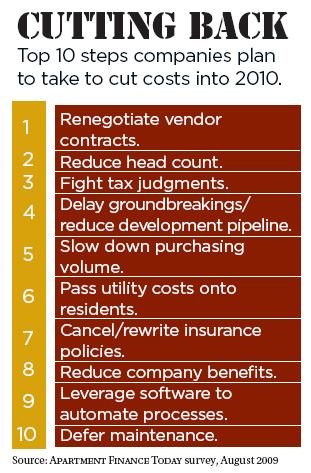The Gen Y set is also expected to fly back into urban centers as an alternative to the suburban sprawl of their youth, further benefiting multifamily players with assets in the inner urban rings. “The Echo Boomers have a different currency than their parents,” says Orlando, Fla.-based ZOM Residential’s president Steve Patterson. “They don’t want the biggest cars and the biggest apartments; they just want to live in a city with a good quality of life.”
The economy in and of itself could demand a shift in product type among multifamily developers. Extremely conservative underwriting and strict lender requirements will likely demand equity-heavy projects for some time, placing fatter developments in need of heftier bridge and mezz financing on the back burner. “Projects are going to be smaller,” says High Street Residential’s Lomenick. “They have to be scaled back because we are still going to have a problem with construction debt.”
High Street will consequently focus on smaller niche development opportunities in 2010, looking to track what Lomenick calls a core paradigm shift in multifamily development. “We’re looking at walkable environments, urban environments, environment near transit modes,” he says. “The days of garden apartments on the outer ring of the suburbs are over.”
ACQUISITIONS AND INVESTMENT
5. Don’t Turn Your Back on Acquisitions.
Multifamily portfolio manifestos will continue to march to the call of distressed acquisition opportunities in 2010. How firms define that opportunity, however, is uncertain as the once-expected tsunami of deals hitting the market proves to be more fickle and less flood. Yes, some $300 billion in multifamily debt will come due over the next three years, but belief in a full-out property dump is waning as signs of an economic recovery begin to appear.
“Anyone selling right now is in some form of distress; otherwise, why would you sell anything today?” Simon’s Baron asks. “There’s hundreds of billions of dollars of commercial debt maturing every year into 2012 that will attempt to refinance with stricter underwriting and lower valuations. No matter which way you slice it, people are going to have to come up with more equity—some of them will be able to, some of them won’t—and that is going to create opportunities for acquisitions.”
While buying off of trough earnings in high-barrier-to-entry markets could produce discounts of 25 percent to 35 percent off peak values, many in the industry question whether or not higher-end assets will be available in the 2010 disposition market. That has REITs such as UDR anticipating rehab opportunities over crown-in-the-jewel buys, despite the company’s fortitude and hunger for larger deals.
“We just think there will be a scarcity of Class A product available next year,” says Larry Connor, president of Dayton, Ohio-based owner/operator The Connor Group, which closed on $170 million in acquisitions in 2009. “Unless you’ve got a gun to your head, you are not going to sell.”
6. Know that Cash is Still King.
Simon’s Baron says construction loan qualifications effectively shut most borrowers out of the debt markets, necessitating a dry powder strategy for 2010 multifamily market movers. “I don’t want to say there is no construction financing out there, but it is effectively a cash business today,” Baron says. Even on the acquisition side, deal preference is migrating to cash-in-hand buyers who can guarantee speed of execution and certainty of closing over those seeking to access agency lending as part of their acquisition strategy.
“We’re sitting on $80 million in cash, an untapped $600 million line of credit, and an investment fund of approximately $1 billion in acquisition/development capacity,” says Camden’s Campo. “The most important part of preparation for 2010 is making sure you have the capital.
